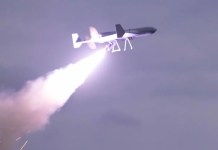South Korea has unveiled the prototype of its latest fighter jet, ‘KF-21 Boramae’. At $7.8 billion, this is Seoul’s most ambitious and costliest weapons program to date.
With this, South Korea becomes one of the few countries to have successfully developed an aircraft with limited stealth capabilities.
The Indian Hal AMCA is expected to be similar to the KF-21 with both being twin-engine jets with an estimated take-off weight of around 25 tonnes. While similar in layout to the KF-21, the AMCA is being designed with an internal weapons bay, writes TheWire.
The Boramae, (meaning ‘Hawk’ in English), made its first public appearance at a spectacular ceremony on Friday. At $7.8 billion, this is Seoul’s most ambitious and costliest weapons development program to date.
The indigenous aircraft is expected to take its maiden flight in 2022, and the country is expecting to induct 40 such fighters in the next seven years and have the full fleet of 120 aircraft deployed by 2032.
The fighter is described as a twin-engine multirole jet, and despite its physical resemblance to a stealth aircraft, it is a fourth-generation fighter jet and does not carry weapons in internal weapons bays.
The aircraft has 10 hardpoints capable of mounting advanced air-to-air and ground strike munitions including the Meteor, AIM-120 AMRAAM, AIM-9 Sidewinder, IRIS-T, and even air-launched cruise missiles (ALCM). However, it isn’t clear if the aircraft would carry an internal cannon.
The weapons have already been selected for the type’s Block-2 version, which includes GBU-12 Paveway II, GBU-31/38 Joint Direct Attack Munition (JDAM), GBU-54/56 Laser JDAM, GBU-39/B Small Diameter Bomb I, and the CBU‐105 Wind Corrected Munitions Dispenser (WCMD). All these stores are currently in service with the Republic of Korea Air Force which should accelerate the integration process.
The KF-21, a result of the KF-X advanced multirole jet fighter project, is intended to produce modern warplanes to replace South Korea’s aging F-4D/E Phantom II and F-5E/F Tiger II aircraft and shall complement the F-35 Lightning II fighters in the future. The country has already received 24 F-35s from the United States.
However, developing an indigenous fighter jet comes with its own set of challenges, and the Korean Aerospace Agency (KAI) has already amassed vast experience in producing military aircraft including its homegrown FA-50 light combat aircraft and the local production of F-16C/Ds in use by the ROKAF.
In an analysis, defense expert Thomas Newdick notes that the aircraft indeed possesses some low-observable features adopting the canted twin tails, fuselage shaping, and edge alignment, among other features, established by the F-22 and F-35.
Although it does not possess advanced stealth features as in the case of the American fifth-generation duo, this twin-engine jet is intended to fill the gap between the F-35 and the F-16, in terms of capabilities, but should be cheaper than the F-35, the sustainment cost of which is a cause for concern in the United States and elsewhere.
Indonesia has joined the project with Jakarta promising to pay 20 percent of the development cost and acquisition of 50 aircraft for its air force. The prototype that was on display on Friday also had the South Korean and Indonesian flag markings on it.
The aircraft will have a maximum speed of Mach 1.8, and a maximum takeoff weight of around 25 tons. It will be powered by two Hanwha Techwin General Electric F414-KI afterburning turbofan engines producing 57.8 kN (13,000 lbf) thrust each.
Follow EurAsian Times on Google News




